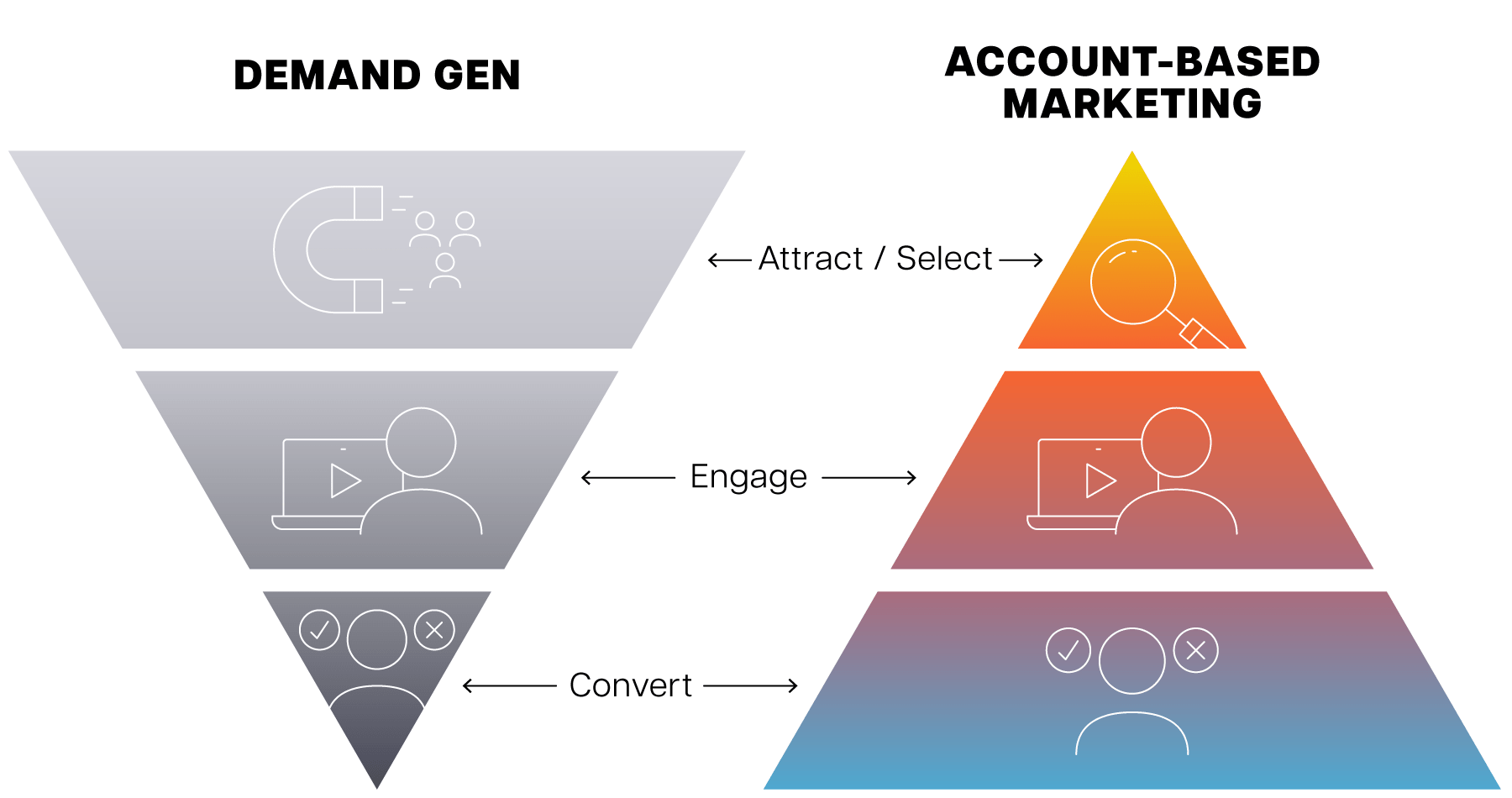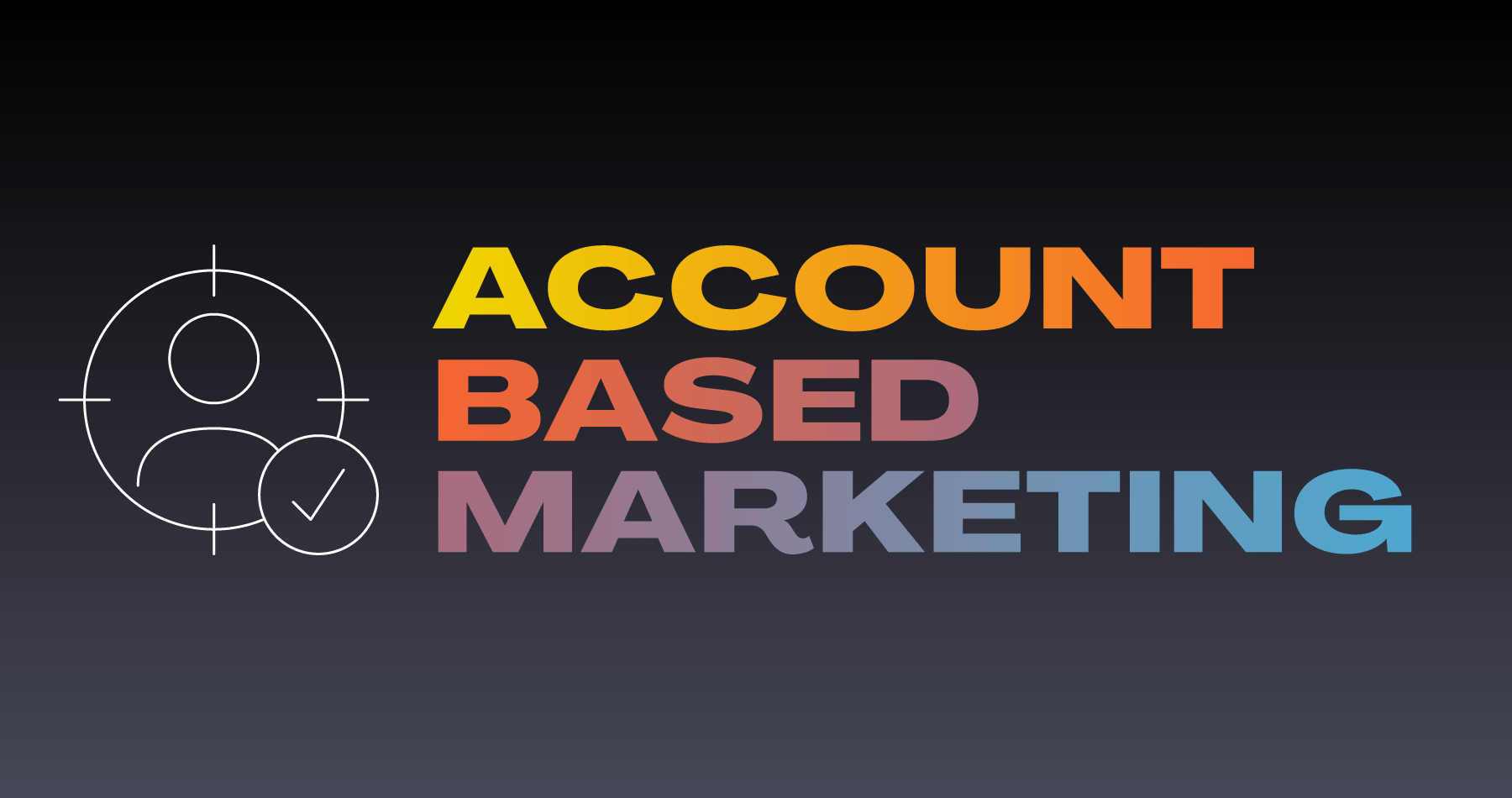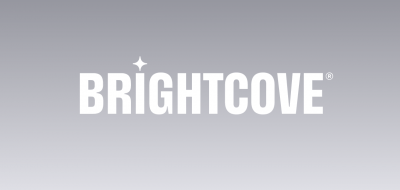In 2020, only 15% of B2B marketers were using Account-Based Marketing (ABM). By the following year, that number had skyrocketed to 70%.
The success of ABM goes beyond increased deal sizes and a better ROI. It offers other benefits like a more efficient use of budget and better engagement with both prospects and customers.
Regardless of objective, all ABM campaigns share common attributes including personalization, specific targeting, and an aim to deeply engage, not just sell. To those ends, video can be a strong tool that delivers all of these attributes and should undoubtedly be a part of ABM strategies.
WHAT IS ABM?
HubSpot defines ABMas “a strategic approach that focuses on high-value accounts in a market or business.” Indeed, its focus on personalization better addresses a segment’s unique needs and use cases, and it better prepares an account for sales outreach.
Traditional B2B demand generation uses the funnel approach, casting a wide net to attract a large number of leads before engaging the most qualified prospects. In contrast, ABM inverts the funnel. It begins by selecting key accounts, and then engages them through various touchpoints and interactions customized specifically for those accounts.

BENEFITS OF ABM
BUDGET EFFICIENCY
With ABM, target accounts are researched and identified as having a high likelihood of conversion. Budget and resources can then be focused on these accounts rather than a large pool of prospects—many of whom will never convert.
However, the laser-like focus on specific accounts can come with a tradeoff. Traditional demand gen may have lower conversion rates, but it also generates more brand awareness that can pay off later. Depending on your business and industry, consider reserving some budget for campaigns that maintain brand recognition and recall with general audiences.
BUYER JOURNEY ALIGNMENT
Today’s B2B buyers are more informed, empowered, and independent than ever before. Rather than taking a traditional linear path, they often circle in and out of buyer stages, skip steps, or explore other solutions in parallel.
An autonomous approach to research and early decision-making can often evade traditional lead scoring models. Against this backdrop, ABM is more effective partly because of its focus on creating opportunities to explore content, rather than creating rigid paths to consume content.
Certainly, opportunities for content exploration are still “mapped” and based on data. But the goal is to engage accounts in a more holistic manner rather than merely directing them toward the next prescribed action. Lead scoring can accommodate this by measuring sequences of engagements rather than isolated interactions.
WHAT IS ABM VIDEO?
With traditional demand gen, top of the funnel videos are focused on building brand awareness for a wider pool of prospects. Common examples could include product sizzles that cover a variety of value props and outcomes.
As prospects move further down the funnel toward the consideration phase, the videos gradually become more specific. These videos may include content like product demos and how-tos focused on specific outcomes and features designed to help prospects decide on particular solutions.
ABM starts specific, based on research around the challenges, pain points, and opportunities for each particular company. The goal is not just to sell, but to build confidence that you understand their unique circumstances and have the best solution to address them.
For example, product demos and how-tos are personalized to the company needs identified with each account. Gradually, videos become more personal, not just to the account, but to the individual contacts and their respective roles. Thus, by building relationships before purchase rather than after, ABM video builds brand loyalty upfront.
HOW TO PRODUCE ABM VIDEOS
While an ABM video strategy can be immensely effective, the sheer volume and customization needed are intimidating. Think about it: Instead of one product demo, you need dozens, personalized to each account group. And that’s for each product.
Fortunately, there are several strategies that can help make producing ABM video more scalable.
MODULAR CONTENT
Successful ABM programs depend on a modular approach to content creation. Traditional marketing videos often span several benefits, features, and even products so they can cater to a broad audience. ABM, on the other hand, is singularly focused: one feature or outcome at a time, customized to a specific account.
Think of each video as a building block. It can stand on its own (i.e., cover a specific use case or need), or it can combine with other blocks of content to address complex use cases.
If you’re not already creating modular video content, this will be the most difficult step. Depending on how your current library is composed, it could require re-editing or even reshooting a number of videos. But as heavy an investment as it may be, it’s also the only way to make ABM video scale.
AI CONTENT SOURCING
If you’ve ever talked to a company trying to sell you a video platform (like us), you’ve no doubt heard the phrase, “you have more content than you realize.” As true as it is, you already know this. The problem lies in efficiently finding this content.
Even in the best-organized libraries, it still takes time to source existing content. That’s why Brightcove has partners that employ AI content analysis to quickly surface existing content for you.
You might have a smaller marketing team that often reuses content or a larger one that creates personalized videos using content from multiple sources. Either way, AI can help you keep up with ABM production demands.
PERSONALIZED BUMPERS
Another way to scale ABM production is through personalized bumpers. You can add them to the beginning or end of any modular video and quickly create custom content for different industries, use cases, and accounts.
Take for example an ABM campaign targeted at the healthcare industry with the goal of highlighting how your products enable them to innovate and stay competitive. You could customize the content with bumpers that showcase the logos of well-known healthcare providers. Additionally, they could include associated metrics, testimonials, or any other information that help better communicate your value proposition.
INTERACTIVITY
Incorporating interactivity into your ABM videos offers another layer of personalization. Mentioning the viewer’s name, account, or industry helps capture their attention with the promise of relevant, personalized content.
Interactivity offers a wide variety of ways to personalize videos, including embedded links, polls, forms, live chat, chapters, and branching. An additional benefit is that it offers more opportunities to explore your company, products, and solutions.
HOW TO DISTRIBUTE ABM VIDEOS
Distributing ABM videos is equally important as producing them. Just as production shouldn’t overtax your video team, distribution shouldn’t exhaust your web team.
With tools like Brightcove Gallery, you can quickly create personalized landing pages for each account in minutes. For high-value accounts, you can go a step further and create immersive portals that have the same look and feel as a streaming service.
If you prefer, you can also use your own CRM or Marketing Automation Platform (MAP) to create the landing pages and simply embed your personalized videos.
HOW TO SUCCEED WITH ABM VIDEO
ABM is a fundamentally different approach to video strategy. Not only do you need to rethink production and adopt scalable personalization techniques, you need access to user-level data so you can measure account engagement.
Tools like Brightcove Marketing Studio allow you to integrate with your CRM and/or MAP for user-level reporting. Since buyers don’t follow linear paths, you need to know which accounts are engaged and which approaches work best.
Using these marketing strategies, platforms, and AI video partners can help you develop and enhance your ABM campaigns in ways that resonate with your top-priority targets.
This blog was originally written in 2019 by Rose Morabito and has been updated for accuracy and comprehensiveness.


